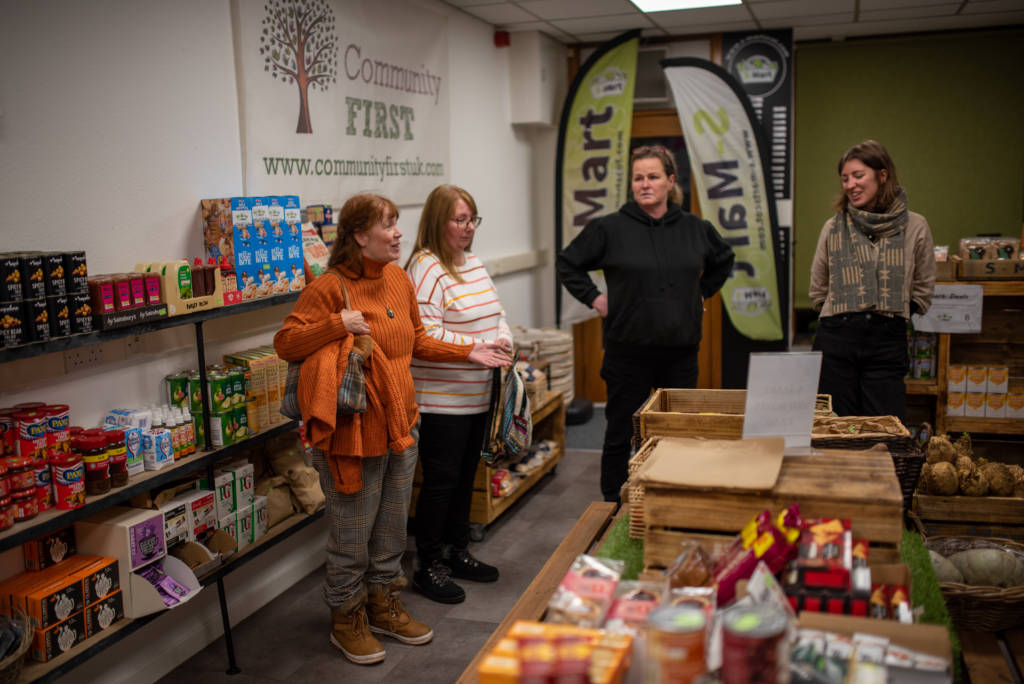
05.12.22

CULTIVATE is a Tay region Culture Collective project which places creativity at the heart of climate justice by developing action with local communities. Creative Dundee holds the belief that creative practitioners can help promote communication and the growth of ideas in, with and for communities.
There are many factors that can predict a person’s vulnerability to climate injustice, but poverty is both an indicator and an effect. On a global scale we have lost fragile ecosystems; there has been an increase of natural disasters, and crop yields are less abundant. We can’t grow as much food and you don’t need to be the farmer, or even the consumer, for this to impact you, as all costs and interest rates rise in line with the challenges. If the resources are compromised, the gap between rich and poor will continue to widen.
Aside from being famous for bridies (Plain or flaky?) I have little experience of Forfar; a market-town in central Angus, even though it is only half an hour away from Dundee. In recent years, like many other places, it has become one of declining industries, a slowing high street and a community that struggles to retain its young people.
The Scottish Index of Multiple Deprivation (SIMD) is a map that breaks the country down into a colour coded overview of where each ward sits within the percentage pie, from red (most deprived) to blue (least deprived). Scores are generated from statistics on income, geographic access rates, crime and other factors. Rolling the cursor over Forfar for the latest figures (collated in 2020), there is an overall cooler hue to the map when compared to the City of Dundee, and there is no maroon which represents the most deprived ten percent in Scotland.

At first glance, the map doesn’t indicate that Forfar is in relative difficulty. Like everything else that is quantified by averages though, this information can provide a skewed snapshot to anyone who wants to know what it is really like for most people living in market towns and more rural communities. In order to come to the understanding that some of the features of poverty differ geographically and that the elements of the playing field are uneven, it was useful for me to reflect on my own city as well as hear from people who are from places outside Dundee.
When you look at the Tay region as a whole on the SIMD map, Dundee shouts ‘FIRE!’, ablaze with areas of maroon, red and orange. The indication of poverty here has been apparent for decades and has shaped our society and resilience. We have a city council that isn’t scared to speak about poverty and is one of the first to have a Fairness Commission formed by a panel made up of people with lived experience of poverty and other barriers to access and inclusion. There is a huge third sector influence, and organisations like Dundee Carers Centre, Dundee Bairns and Women’s Aid are embedded. There are lots of opportunities for advocacy and support.
Angus, Perthshire and places of similar geography tend to have to hold their heads high. After all, they want young people and families to stay in the area. They also rely heavily on tourism and income from holiday seasons. The loss of almost two seasons thanks to the Covid-19 pandemic has had most small towns on their knees. Their high streets are even more vulnerable to the cost of living crisis and the impending climate disaster, and much of Angus is easily flooded, as happened recently in Alyth and Brechin. The reasons for isolation in individuals within Angus, especially those in the lower SIMD areas, are complex. There may not be a ‘maroon area’ in Forfar, but the pockets of deprivation that stud Angus are home to some of the most deprived people in the country when it comes to barriers to employment, mobility, income, education and health. Paired with less access to sufficient services, advocacy and opportunities to engage, it can limit anyone’s belief in a better future if you are not one of the wealthy.
Although in Dundee the scale of the issues are felt with urgency, the idea of hope for individuals and as a whole is something that seems to be more accessible. From within a city, there is by default more opportunity to connect and to have our difficulties in health and wellbeing heard – even if it’s only through the number of resources available. An ageing population, reasonable property prices and links to farming pulls the averages up to mid-range in Forfar, but the fact is that for most young people, families, and pensioners, it can be a place of insufficient resources.
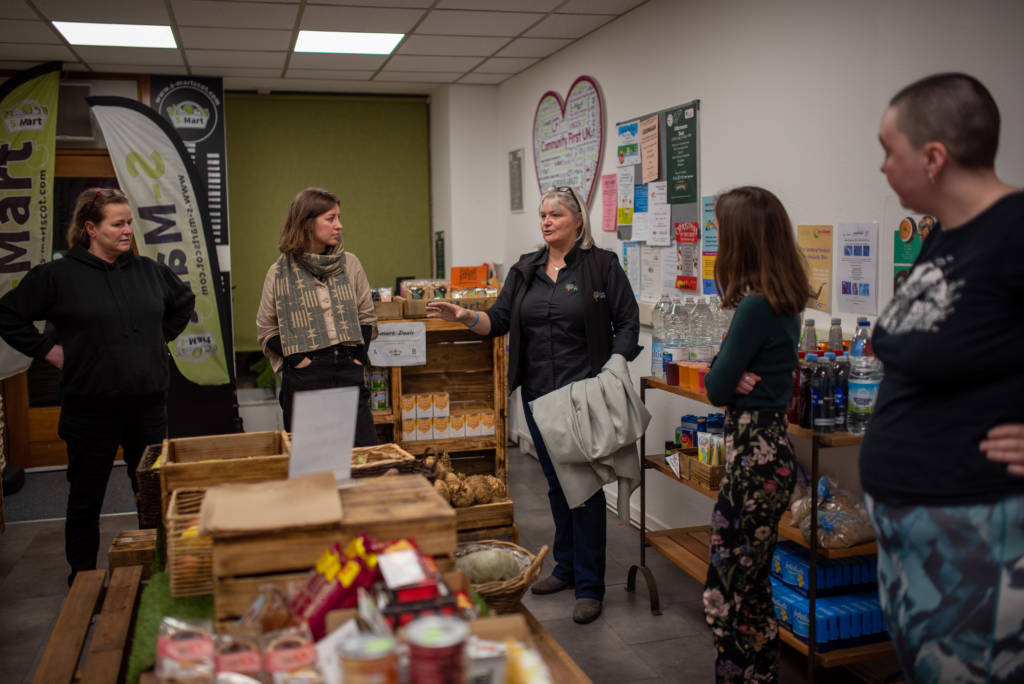
On the evening of Wed 9 November, our latest CULTIVATE event was held on Forfar High Street at a place that could easily be mistaken for a little co-op or farm shop. S-Mart is a social supermarket, and the first of its kind in Angus. Beside it is BRAND, a different take on a charity shop, and from the back you can access The Little Green Café. The enterprises were co-created by local women Pauline Lockhart and Carol Malone, backed by Community First, whose purpose is ‘to help those who help, volunteer and support their communities’. As the pandemic hit in 2020, S-Mart was still in its planning stages as a new enterprise, whose aim was to reduce waste by tackling food insecurity. The plans had to be redrawn. When I visited for the first time I found it hard to comprehend what has been achieved in only two years.
With waste reduction and sustainability in mind, our CULTIVATE gathering was catered by The Little Green Café; vegan, and mostly made up of food that would otherwise have been disposed of by supermarkets. When we toured the fridges and displays, the fact that this would have all gone to waste was shocking to all of us. This wasn’t a few wilted vegetables and things going past their sell by date ‘tomorrow’. There were items from nearly every department you would find in a supermarket, and it helped us to more accurately grasp the scale of the issues that are creating a devastating effect on our environment. The cut price supermarket is open to everyone, and the staff tell each customer in what way they have helped people and the planet at the checkout. The café uses some of the stock to make profit for the running of the enterprise, and it provides a cosy space for us to spend a little time, without the pressure of buying. There are couches, a bookcase and free internet access. There is a coffee machine for barista training and they aspire to become a training kitchen.
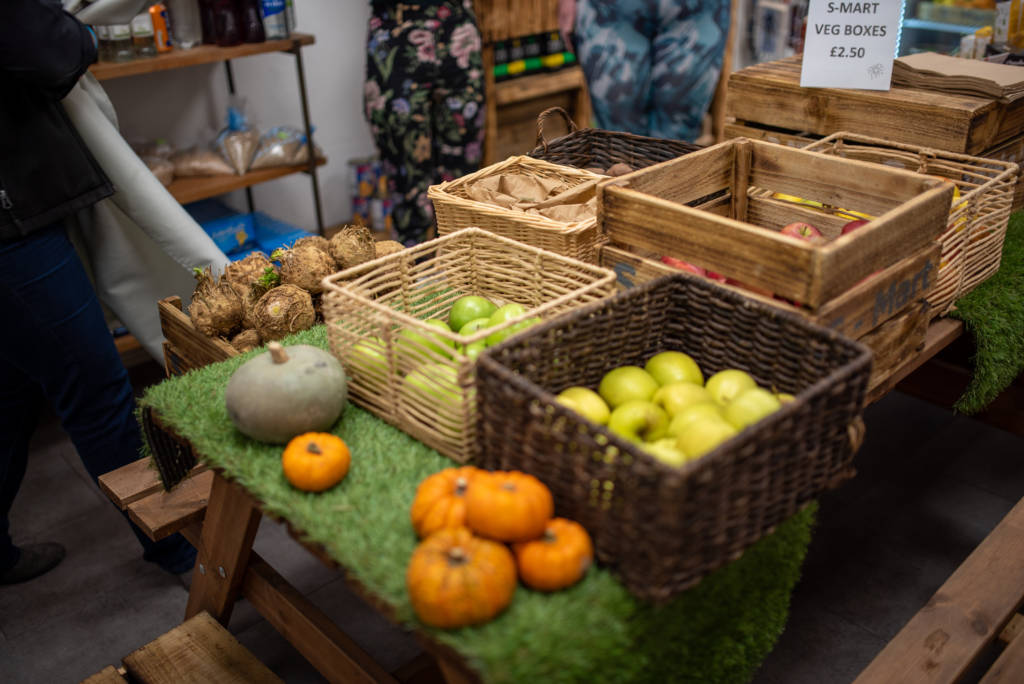
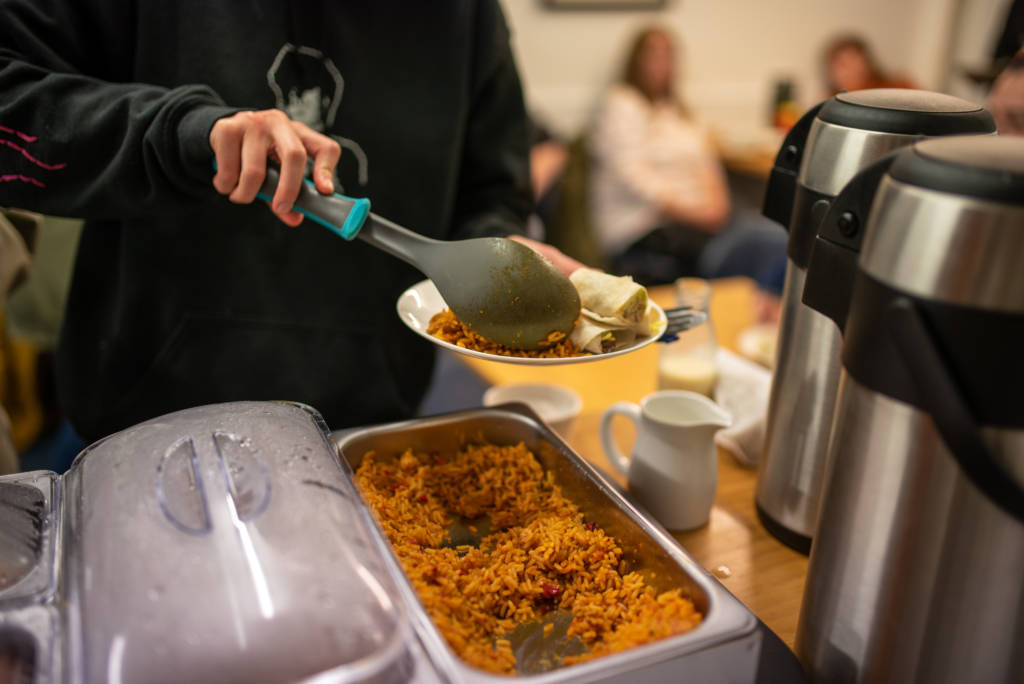
Our group of creative practitioners and residents of Forfar and the surrounding area, first enjoyed an inspiring talk from Pauline who told us about her journey developing the business. Although she sees the use of ‘bank’ services as being crucial in recent years, she hopes that one day they won’t be needed and social supermarkets and community fridges/larders become a more community focused and dignified way to help people and the environment whether you are considered ‘in need’ or not. Through S-Mart and BRAND, they are beginning to do this by finding ways to illustrate the benefits of their way of shopping to potential customers. To help people who need free food or indeed clothing, they work in a more progressive way. They don’t require a referral or explanation, and the conversations around the shift away from the traditional food and clothing bank model is the stuff of real cultural and attitudinal change.
BRAND is a shop that looks like a regular clothes and gift shop. Its clean lines, carefully curated rails and wall and plinth displays make it feel like we are in a unique little boutique. The clothing and shoes are donated and there are affordable gifts in the form of artwork by local creatives. There are surprise fashion bags at low prices, and they sell through Vinted as well to sustain the business. They have achieved their aim to not feel like a ‘charity shop’, and some of the benefits of this can mean that young people who are not ‘second hand inclined’ can buy here with less of the stigma. Pauline told us about a teenage boy who got a brand new pair of designer trainers from his mum who was a single parent. The mum was able provide him with something she otherwise couldn’t afford, without compromising her son’s self esteem. Her relief and happiness was felt by the staff, and this is a common occurrence in BRAND when people find not only a great bargain, but can leave with joy and raised feelings of self-worth. Like all other great work that benefits communities and individuals, their ability to see and feel from the perspective of others is evident.
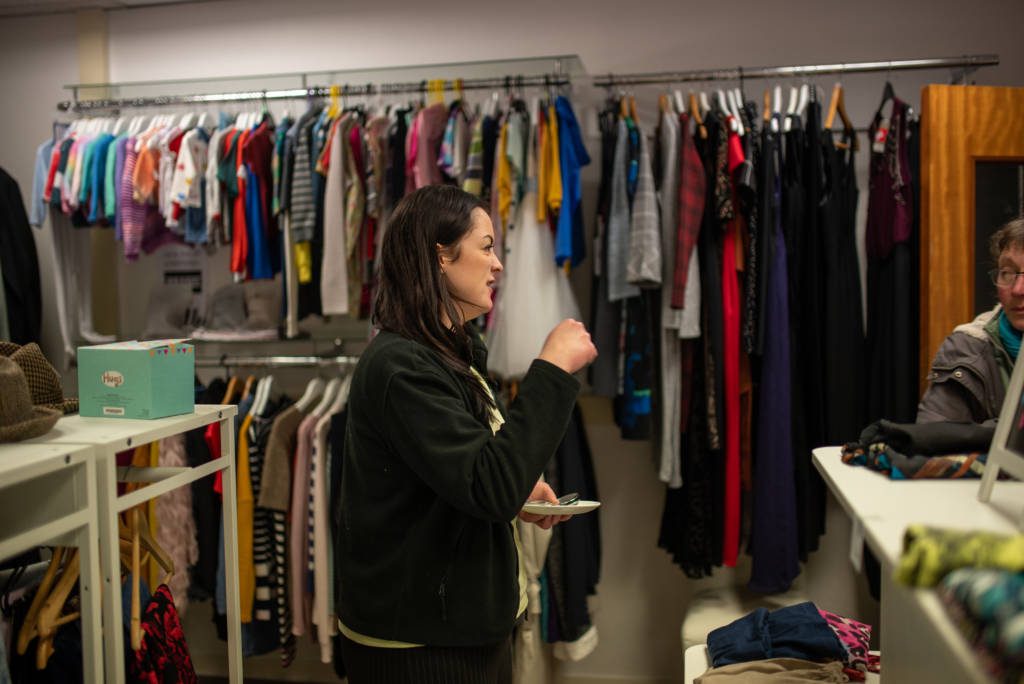
As we finished our meal, we heard from Lyndsey Duncan from Kirriemuir Food Hub. Kirriemuir is fifteen minutes north west of Forfar, and has a similar SIMD landscape. I had visited to chat with them about the level of need in the area in regards to food insecurity. When I visited and arrived a little earlier than I was due, I waited in the back and within that half hour I heard three examples of exactly why they do this work. I witnessed some of the complex challenges affecting families as one of the visitors openly shared their experience. Like in Forfar, there is no prying into why they need help at the hub. The service is provided ‘no questions asked’, and they too believe in providing choice and autonomy. Leonie Kiely, a retired school teacher and the team seem to be a real source of support in their community as along with the bags of shopping, supplied by the local supermarkets, the space to talk and simply ask people how they are, means that they leave the hub not only with food but feeling seen and heard. As we chatted once the doors were closed for the day, Leonie told me about the level of need in the area increasing, even since 2020.
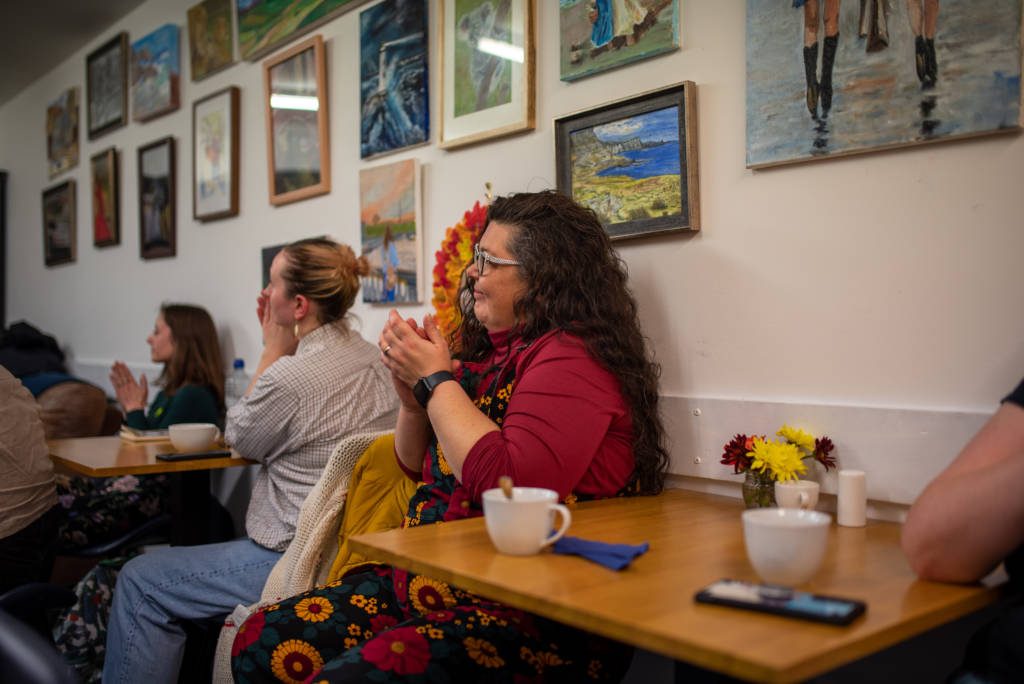
Lyndsey, who owns the pub attached to the food hub, started it up in the pandemic with Leonie and some other volunteers. She thought that it would be ‘something she did for a few weeks’ since the pub couldn’t open, and she knew that there were people locally who needed meals and supplies. They cooked soups and lunches for people before they went into the supply of groceries and essential items. Kirriemuir Food Hub managed to save ‘the weight of three African elephants’ from waste in their first year, and they continue to challenge climate injustice head on. The feeling of being able to do something for others in crisis is one that can’t be matched, and problem solving in entrepreneurial and innovative ways is something that requires short and long term vision and creativity. The meeting of these incredible women doing so much for food insecurity in Angus was a special event to behold as they gave us great insight into their process.
The final speaker that evening was Richard McGonigle, who is a voluntary development worker for Forfar Open Garden. This is a community garden that has been open since 2015, and its manager Jen has developed a place that they try to make as accessible as they can for everyone. They take referrals from services that can see the benefit of gardening and being outdoors for mental health and wellbeing. Schools, groups and individuals are all welcome. There is an orchard, planting beds, greenhouses and a forest area that has a designated place for fire making. There is also a garden room that is used as a place to rest and enjoy creative workshops, meetings, and as a welcome space. When I visited there were some young people sitting enjoying a conversation with a cup of tea on the comfortable seats. I remember thinking that I would have loved a place like this when I was a teenager.
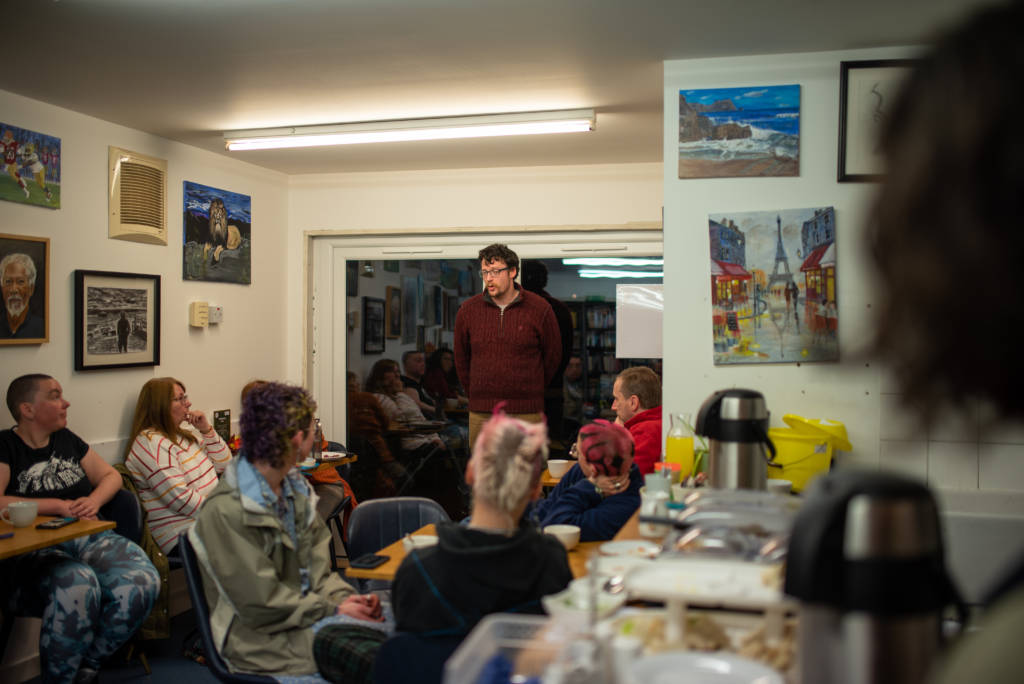
At our event, Richard posed some interesting questions about the role of creativity in the issues of climate change, and asked how creative practitioners can use their skills to the benefit of small organisations that don’t always have the time and resources to work with each other, highlighting the importance of communication. He suggested that artists are skilled in ways of seeing, and potentially have the ability to communicate the objectives of the project to the right people. He is keen to encourage creative growth and local collaboration in Angus, so his enthusiasm for finding new ways to engage was felt.
The evening finished with the opportunity to chat about the issues raised by the speakers, and we had a chance to do some shopping in BRAND. Those who hadn’t visited before found the place to be inspiring, and the creative practitioners had access to some valuable examples of process, engagement and solutions already being explored in Angus.
For our CULTIVATE programme, poverty action is the focus in Angus, and the challenge of raising the voices of those affected by the specific issues of this demographic area is the aim. There will be a ‘storyteller’ commissioned to link the activities to each other and us, documenting the process, successes and findings of the programme. Impactful results are needed for Tayside, as for the average person in Angus the issues can only be described as ‘different rather than less’ than in the closest city. There, the issues of climate injustice can be stark and isolated groups and individuals even more vulnerable. If understanding is borne out of communication, then creatives have a great chance of being instrumental in real and radical improvements to our world.
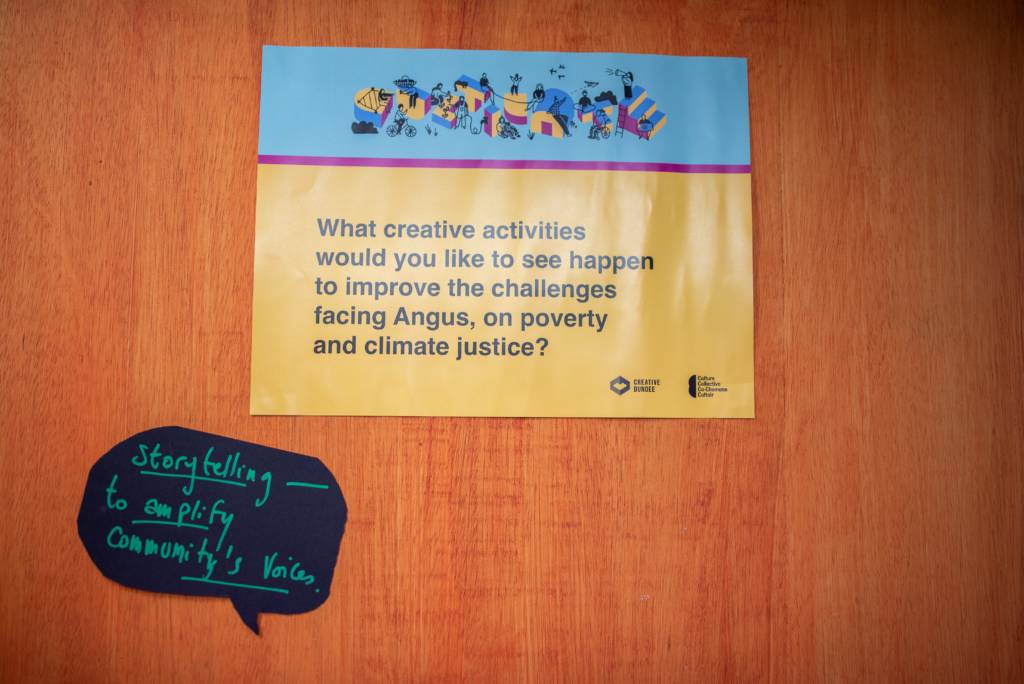
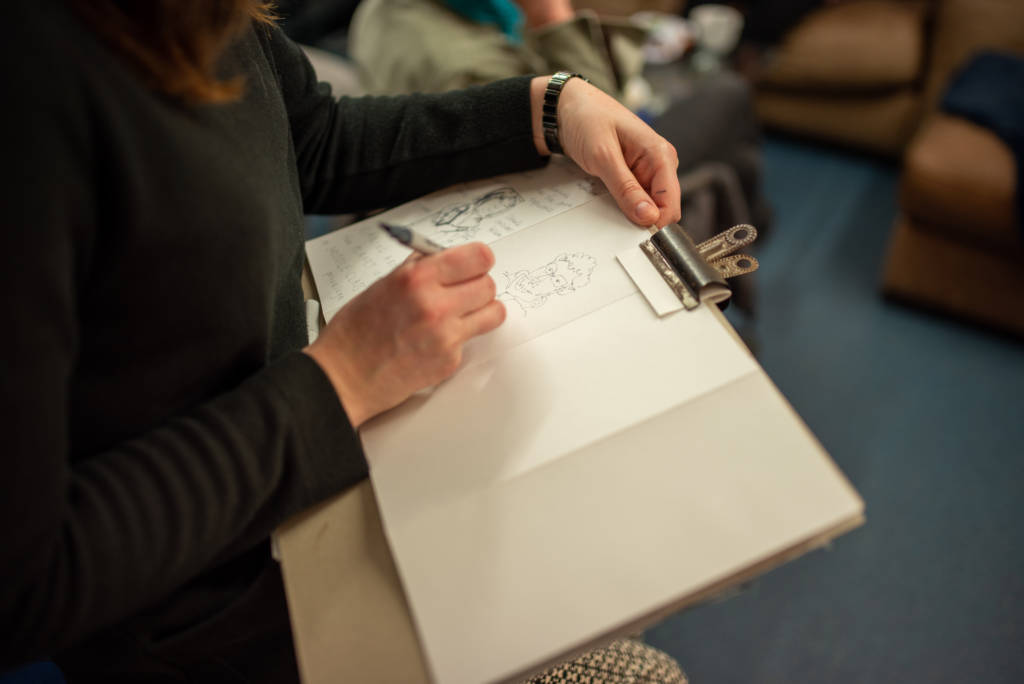
Find out more about our first event in the #CultivateTay Climate Justice series or browse photos from both events over on our Flickr.
Discover more about CULTIVATE and the second round of creative practitioner commissions.

If you would like to support us in creating even better content, please consider joining or supporting our Amps Community.